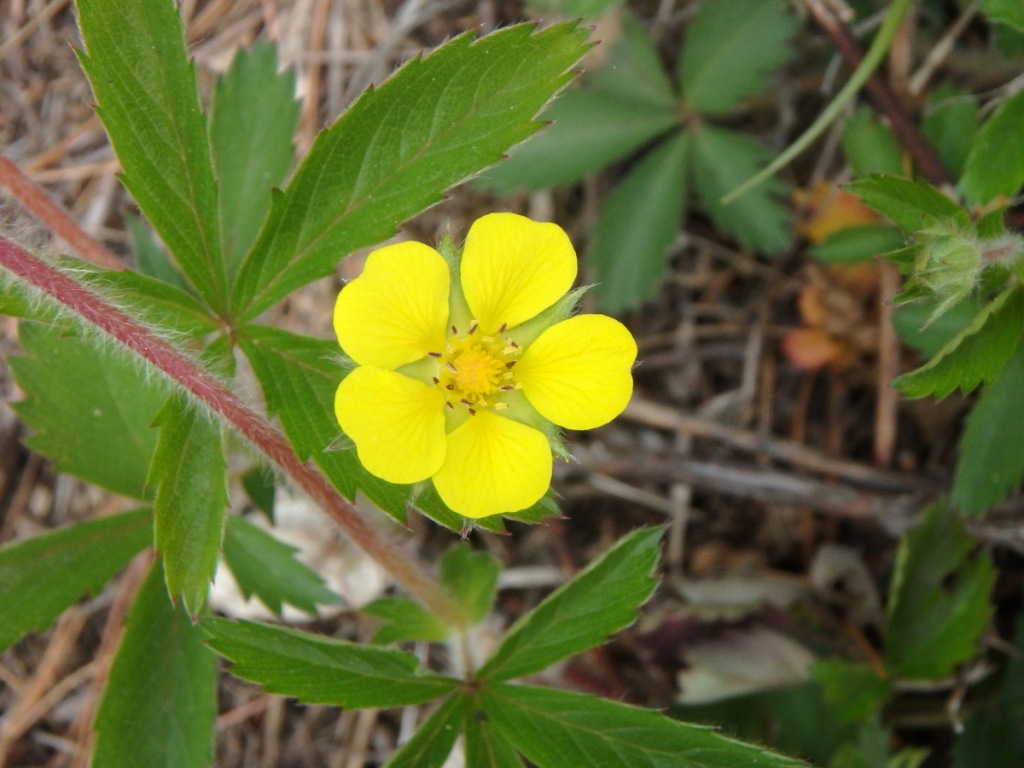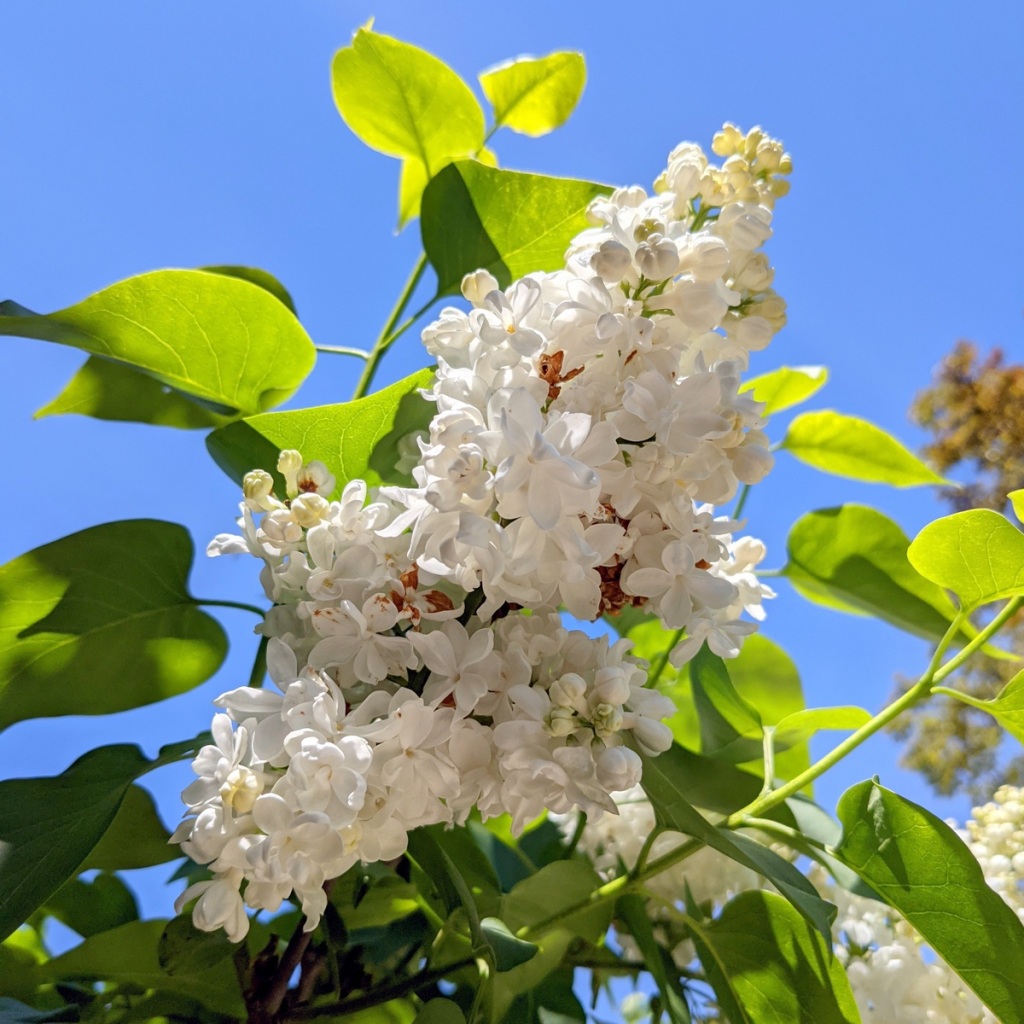
Goldthread (Coptis groenlandicum), one of our prettiest spring flowers, has just come into bloom. The hook shaped parts are its tiny styles, curved like long necked birds. The male stamens are too numerous to count and white tipped, so I’d guess the pollen must be white. The white, petal like sepals last only a short time and will fall off, leaving the tiny, golden yellow true petals behind. The ends of these golden petals are spoon shaped and hold nectar. You can see how an insect would have a hard time sipping the flower’s nectar without bumping into the stamens and carrying off a load of pollen. All of this is going on in a flower just about the size of a standard aspirin.

If you’re looking for goldthread you can find it even in winter, because its shiny leaves are evergreen.

The first blueberry blossoms I’ve seen this year were on a lowbush blueberry (Vaccinium angustifolium). Though the berries are usually close to the same size, lowbush blueberries rarely get more than 2 feet tall while 15-foot-tall highbush blueberries have been seen. I usually find them at about six feet or less. Native Americans called blueberries “star berries” and used the plant medicinally, spiritually, and of course as a food. One of their favorites was a pudding made with dried blueberries and cornmeal.

Coltsfoot leaves (Tussilago farfara) have appeared and, though they have the same color and sheen when young as a wild ginger leaf they’re much bigger and are shaped like a colt’s hoof rather than heart shaped like ginger.

With coltsfoot plants once the leaves appear the flowers pass on, but they had a good run this year. They liked the cool weather and bloomed for weeks. The seed heads are much furrier looking than a dandelion.

But at this time of year flowers come as quickly as they go, and it’s time for the shadbushes (Amelanchier canadensis) to bloom. This scene is a classic shadbush scene, because they almost always bloom along the edges of forests under the taller trees. They are a spring ephemeral shrub / small tree so the flowers will disappear as soon as the leaves come out on the taller trees.

Shadbushes originally got their name from the way they bloomed when the shad fish were running upriver to spawn. Another name, Juneberry, refers to when its fruit ripens. The fruit is said to resemble a blueberry in taste, with a hint of almond from the seeds. Many birds, such as cedar waxwings, love the fruit. Native American used the fruit in pemmican, which is made with fat, fruit, and preserved meat. Shadbush wood is brown, hard, close-grained, and heavy. Native trees can also be very straight, often reaching 25 feet, and Native Americans used it for arrow shafts. They also used its roots and bark medicinally.

Shadbush makes an excellent garden shrub or small tree and they are easily found in nurseries. This photo shows a cultivar I found at the local college. Cultivars have a much heavier bloom than natives.

Along with the shadbushes our native cherries start blossoming. New Hampshire has four native cherry trees: black cherry (Prunus serotina), choke cherry (Prunus virginiana), pin cherry (Prunus pensylvanica), and wild American plum (Prunus americana). The blossoms in the above photo are pin cherry blossoms. Choke cherries will bloom any time now. Just after, or sometimes along with the cherries will come apples and crabapples.

Sedges are still flowering. I think this one was Pennsylvania sedge (Carex pensylvanica) but I wouldn’t bet the farm on that. They usually bloom when trout lilies bloom and that’s just what has happened this year.

But while the sedges are having a good year, so far the trout lilies (Erythronium americanum) have made a poor showing. The spot I go to see them has many hundreds of plants in it but there were only three or four blossoms. I’m hoping I was just too early, so I’ll go back. Trout lilies are in the lily family and it’s easy to see why; they look just like a miniature Canada lily. The six stamens in the blossom start out bright yellow but quickly turn reddish brown and start shedding pollen. Nectar is produced at the base of the petals and sepals (tepals) as it is in all members of the lily family, and it attracts several kinds of bees.

You can tell by the dark anthers that this flower has been open longer than the one we saw in the previous photo. It’s hard to get a shot of them when they don’t have swept back petals because it happens almost immediately after they open.

One of my favorite things about a trout lily blossom is the coloring on the back. Another name for the plant is fawn lily, because the mottled leaves reminded someone of a whitetail deer fawn. Native Americans cooked the small bulbs or dried them for winter food.

The trees are quickly leafing out already and that means less sunshine each day for spring ephemeral flowers like spring beauties (Claytonia carolinana). I’m seeing fewer blossoms each time I go to see them and this time I had to search for them, so I think it’s getting time to say goodbye to them for another year. I hope I’m wrong though because I love seeing them.

I’ve noticed some fading petals on some of the red / purple trilliums (Trillium erectum) as well but I hope that doesn’t mean they’re already done for the year. I don’t think they’ve been blooming more than two weeks. This one didn’t look too bad.

I see many hundreds of this very small white violets and I always wonder if they could be northern white violets (Viola pallens) but I always forget to look for a spur on the back of the lower petal. They are half the size of the violets that I usually see.

The insect guides are deep purple and the side petals may or may not have hairs on this generally non-hairy violet. They’re pretty little things and they’re everywhere right now.

Creeping phlox (Phlox subulata) is native to North America but it acts like an invasive somewhat, because it just pops up in lawns everywhere in this area. Here it was growing in the lawn of an abandoned house. It is sometimes called moss phlox or moss pinks and luckily it doesn’t seem to mind being mowed. Many people wait until it’s done blooming to do their first spring mowing.

Another plant called creeping phlox is Phlox stolonifera that has much the same habit, but it is native only as far north as Pennsylvania. One way to tell them apart is by the darker band of color around the center of the flower; if it is there your plant is Phlox subulata and if it isn’t it is Phlox stolonifera.

Bleeding hearts (Dicentra spectabilis) have just come out and they were beautiful. I was just reading that this is a member of the poppy family, which I hadn’t heard before. It is native to Siberia, China, Korea and Japan, and I didn’t know that either. My son just returned from Korea and he says it’s beautiful there. With flowers like these, I’d bet that it is.

I liked the color of this tulip. Tulips seem to be having a good year this year.

Lilacs are taking their time but it shouldn’t be too much longer before we can smell their wonderful fragrance again.

I don’t know what was going on with this dandelion but it takes first prize for the strangest dandelion blossom I’ve ever seen. All the parts are there but they’re all discombobulated. Maybe it is a sport, which is a genetic mutation. Sports are very important to the nursery trade and we unknowingly grow a lot of them in our gardens. This dandelion appears to be trying to become a double flower. I applaud its nonconformity but I’m sure many will see it as an ugly thing. As a gardener I met many people who thought they hated dandelions, but there was a time in years past when grasses were dug up so that dandelions would have more room to grow, so it’s all in how you look at it. Personally I like to see them for what they are, which is just a pretty yellow wildflower. It’s the only flower I’ve found blooming in all twelve months of the year.
Flowers don’t worry about how they’re going to bloom. They just open up and turn toward the light and that makes them beautiful. ~Jim Carrey
Thanks for coming by.








































































































